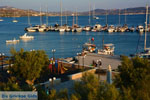Papafrangas - Milos (Greece)
Papafrangas (Papafragkas). Papafrangkas is a narrow beach and also the name of a large sea cave on the Greek island of Milos. Stunning rock formations form a number of fjords. Papafragkas lies on the route between Adamas and Pollonia, just three kilometers (less than 2 mi) before Pollonia. Among the white-grey and sometimes red or brown rocks in the sea you can see several caves. The name “Papafragkas” is derived from the names “Papás” which means priest and “Fragkos” that means “Frankish,” referring to the peoples who inhabited the lands that became modern-day France. In the Middle Ages a Frankish priest lived here and left his boat at the beach when he entered the country. During the Byzantine period pirates hid here.
Coming from Pollonia, just before Papafragkas, the ruins of Filakopi are found. During the Minoan period it was an important trade and distribution center of volcanic glass (obsidian). In Filakopi you’ll see many important artifacts from the period of 3300 to 1100 BC. Many of these objects are housed in the archaeological museum in Plaka and in the Archaeological Museum in Athens.
Diagonally opposite Papafragkas and Filakopi are the islands called Glaronisia. These are a number of rocks and islets, with impressive form - the result of volcanic activity in the area. The islands take on the form of vertical square tubes that are stuck together. On one of the islands is a sea cave through which small boats can sail. The colors of the sea are stunning, sometimes light, sometimes dark and sometimes turquoise.
Text: Jorgos and Wendy Nikolidakis - Edited by Katrina Butzer
Photo Gallery Milos - Photos of Milos
Weather forecast Papafrangas (Milos)
Papafrangas in other languages
 Papafragkas (GriekseGids.nl)
Papafragkas (GriekseGids.nl)
 Papafragkas (GriekseGids.be)
Papafragkas (GriekseGids.be)
 Papafrangas (GreeceGuide.co.uk)
Papafrangas (GreeceGuide.co.uk)
 Papafrangas (GriechenlandWeb.de)
Papafrangas (GriechenlandWeb.de)
Milos: Where on the map is Papafrangas located?















